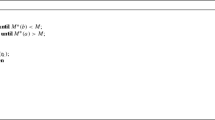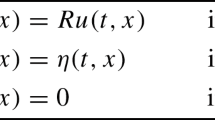Abstract
The paper describes a continuous second-variation method to solve optimal control problems with terminal constraints where the control is defined on a closed set. The integration of matrix differential equations based on a second-order expansion of a Lagrangian provides linear updates of the control and a locally optimal feedback controller. The process involves a backward and a forward integration stage, which require storing trajectories. A method has been devised to store continuous solutions of ordinary differential equations and compute accurately the continuous expansion of the Lagrangian around a nominal trajectory. Thanks to the continuous approach, the method adapts implicitly the numerical time mesh and provides precise gradient iterates to find an optimal control. The method represents an evolution to the continuous case of discrete second-order techniques of optimal control. The novel method is demonstrated on bang–bang optimal control problems, showing its suitability to identify automatically optimal switching points in the control without insight into the switching structure or a choice of the time mesh. A complex space trajectory problem is tackled to demonstrate the numerical robustness of the method to problems with different time scales.






Similar content being viewed by others
References
Betts, J.: Survey of numerical methods for trajectory optimization. J. Guid. Control Dyn. 21(2), 193–207 (1998). doi:10.2514/2.4231
Ross, I.M., Fahroo, F.: Legendre pseudospectral approximations of optimal control problems. In: Lecture Notes in Control and Information Sciences, vol. 295, pp. 327–342. Springer, Berlin (2003)
Pontryaguin, L.: The Mathematical Theory of Optimal Processes. Wiley, New York (1962)
Speyer, J.L., Jacobson, D.H.: Primer on Optimal Control Theory. Advances in Design and Control. SIAM, Philadelphia (2010)
Fisher, M.E.: Neighboring extremals for nonlinear systems with control constraints. Dyn. Control 5, 225–240 (1995)
Mc Reynolds, S.R., Bryson, A.E.J.: A successive sweep method for solving optimal programming problems. Tech. Rep. AD0459518, Harvard University (1965)
Mitter, S.K.: Successive approximation methods for the solution of optimal control problems. Automatica 3, 135–149 (1966)
Jacobson, D., Mayne, D.: Differential Dynamic Programming. Elsevier, New York (1969)
Mayne, D.: A second order gradient method for determining optimal trajectories for nonlinear discrete-time systems. Int. J. Control 3, 85–95 (1966)
Gershwin, S., Jacobson, D.: A discrete-time differential dynamic programming with application to optimal orbit transfer. AIAA J. 8(9), 1616–1626 (1970)
Dyer, P., McReynolds, S.R.: Optimization of control systems with discontinuities and terminal constraints. IEEE Trans. Autom. Control 14(3), 223–229 (1969). doi:10.1109/TAC.1969.1099173
Whiffen, G., Sims, J.: Application of a novel optimal control algorithm to low-thrust trajectory optimization. In: AAS/AIAA Space Fligth Mechanics Meeting (2001). AAS 01-209
Whiffen, G., Sims, J.: Application of the sdc optimal control algorithm to low-thrust escape and capture including fourth-body effects. In: 2nd International Symposium on Low-Thrust Trajectories, Toulouse, pp. 18–20 (2002)
Lantoine, G., Russell, R.: A hybrid differential dynamic programming algorithm for constrained optimal control problems, Part 1: Theory. J. Optim. Theory Appl. 154(2), 382–417 (2012). doi:10.1007/s10957-012-0039-0
Lantoine, G., Russell, R.: A hybrid differential dynamic programming algorithm for constrained optimal control problems, Part 2: Application. J. Optim. Theory Appl. 154(2), 418–442 (2012). doi:10.1007/s10957-012-0038-0
Bertrand, R., Epenoy, R.: New smoothing techniques for solving bang–bang optimal control problems—numerical results and statistical interpretation. Optim. Control Appl. Methods 23(4), 171–197 (2002). doi:10.1002/oca.709
Shamsi, M.: A modified pseudospectral scheme for accurate solution of bang–bang optimal control problems. Optim. Control Appl. Methods 32, 668–680 (2011)
Jacobson, D.: A new necessary condition of optimality for singular control problems. SIAM J. Control 7(4), 578–595 (1969). doi:10.1137/0307042
Colombo, C., Vasile, M., Radice, G.: Optimal low-thrust trajectories to asteroids through an algorithm based on differential dynamic programming. Celest. Mech. Dyn. Astron. 105(1), 75–112 (2009). doi:10.1007/s10569-009-9224-3
Pantoja, J.F.A.D.O.: Differential dynamic programming and newton’s method. Int. J. Control 47, 1539–1553 (1988)
Murray, D., Yakowitz, S.: Differential dynamic programming and Newton’s method for discrete optimal control problems. J. Optim. Theory Appl. 43, 395–414 (1984)
Liao, L.A., Liao, L.: Global convergence of differential dynamic programming and newton’s method for discrete-time optimal control (1996)
Bullock, T.: Computation of optimal controls by a method based on second variations. Tech. Rep., Stanford University (1966)
Bullock, T., Franklin, G.: A second-order feedback method for optimal control computations. IEEE Trans. Autom. Control 12(6), 666–673 (1967)
Olympio, J.: Optimisation and optimal control methods for planet sequence design of low-thrust interplanetary transfer problems with gravity-assists. Ph.D. thesis, Ecole des Mines de Paris (2008)
Olympio, J.: Algorithm for low thrust optimal interplanetary transfers with escape and capture phases. In: AIAA/AAS Astrodynamics Specialist Conference and Exhibit, Honolulu, Hawaii, pp. 2008–7363 (2008)
Lantoine, G., Russell, R.: A hybrid differential dynamic programming algorithm for low-thrust optimization. In: AIAA/AAS Astrodynamics Specialist Conference and Exhibit, Honolulu, Hawaii, pp. 18–21 (2008)
Whiffen, G.: Static dynamic control for optimizing a useful objective. Patent US 6 496 741 B1 (2002)
Jain, S.: Multiresolution strategies for the numerical solution of optimal control problems. Ph.D. thesis, School of Aerospace Engineering, Georgia Institute of Technology (2008)
Izzo, D., Bevilacqua, R., Valente, C.: Internal mesh optimisation and Runge–Kutta collocation in a direct transcription method applied to interplanetary missions. In: IAC (2004)
Ranieri, C., Ocampo, C.: Indirect optimization of three-dimensional finite-burning interplanetary transfers including spiral dynamics. J. Guid. Control Dyn. 32(2), 445–455 (2009). doi:10.2514/1.38170
Hestenes, M.R.: Multiplier and gradient methods. J. Optim. Theory Appl. 4(5), 303–320 (1969). doi:10.1007/BF00927673
Powell, M.: A method for nonlinear constraints in minimization problems. In: Fletcher, R. (ed.) Optimization, pp. 283–298. Academic Press, New York (1969)
Conn, A., Gould, N., Toint, P.: Trust-region methods. MPS-SIAM Series on Optimization, vol. 1. SIAM, Philadelphia (2000)
Rodriguez, J., Renaud, J., Watson, L.: Trust region augmented Lagrangian methods for sequential response surface approximation and optimization. J. Mech. Des. 15, 58–66 (1997). doi:10.1115/1.2826677
Coleman, T., Liao, A.: An efficient trust region method for unconstrained discrete-time optimal control problems. Comput. Optim. Appl. 4, 47–66 (1993)
Kalman, R.: Contributions to the theory of optimal control. Bol. Soc. Mat. Mexicana 5(102), 102–119 (1960)
Bucy, R.: Global theory of the Riccati equation. J. Comput. Syst. Sci. 1(4) (1967). doi:10.1016/S0022-0000(67)80025-4
Jacobson, D.: New conditions for boundedness of the solution of a matrix Riccati differential equation. J. Differ. Equ. 8(2), 258–263 (1970). doi:10.1016/0022-0396(70)90005-7
Miele, A., Moseley, P., Levy, A., Coggins, G.: On the method of multipliers for mathematical programming problems. J. Optim. Theory Appl. 10(1), 1–33 (1972). doi:10.1007/BF00934960
Stoffer, D.: Variable steps for reversible integration methods. Computing 55(1), 1–22 (1995). doi:10.1007/BF02238234
Laurent-Varin, J., Bonnans, J., Berend, N., Haddou, M., Talbot, C.: Interior-point approach to trajectory optimization. J. Guid. Control Dyn. 30(5) (2007). doi:10.2514/1.18196
Betts, J., Huffman, W.: Mesh refinement in direct transcription methods for optimal control. Optim. Control Appl. Methods 19(1), 1–21 (1998). doi:10.2514/2.4231
Hairer, E., Noersett, S., Wanner, G.: Solving Ordinary Differential Equations I: Nonstiff Problems, 2nd rev. edn. Springer Series in Computational Mathematics, vol. 8. Springer, Berlin (2000)
Shampine, L.F.: Interpolation for variable order, Runge–Kutta methods. Comput. Math. Appl. 14(4), 255–260 (1987). doi:10.1007/s10957-013-0274-z
Strange, J., Landau, D., Yam, C., Biscani, F., Izzo, D.: Near earth asteroids accessible to human exploration in 2020-2035. In: 42nd Annual Meeting of the Division for Planetary Sciences of the American Astronomical Society (2010)
Petropoulos, A., Whiffen, G.J., Sims, J.A.: Simple control laws for continuous-thrust escape or capture and their use in optimisation. In: AIAA/AAS Astrodynamics Conference, Monterey, CA, USA (2002)
Acknowledgements
Part of this work has been conducted during the Ph.D. studies of the author, under the sponsorship of Centre National d’Etudes Spatiales (CNES, France) and Thales Alenia Space (France).
Author information
Authors and Affiliations
Corresponding author
Additional information
Communicated by Ryan P. Russell.
Rights and permissions
About this article
Cite this article
Olympio, J.T. A Continuous Implementation of a Second-Variation Optimal Control Method for Space Trajectory Problems. J Optim Theory Appl 158, 687–716 (2013). https://doi.org/10.1007/s10957-013-0274-z
Received:
Accepted:
Published:
Issue Date:
DOI: https://doi.org/10.1007/s10957-013-0274-z




